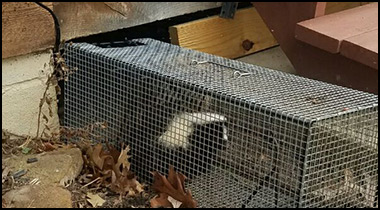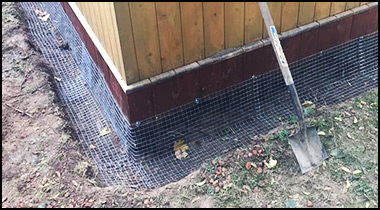Chicago Skunk Removal Resources
Skunk Rehabber - Flint Creek Wildlife Rehab Inc: (847) 842-8000
Free Cook County Animal Services: (708) 974-6140
Humane Wildlife Trappers of Chicago: 773-295-1230
If you need skunk control in Chicago, you have a few options. First, you can attempt to solve the skunk problem yourself by reading our do-it-yourself guide. If you need outside help, you can also call Cook County Animal Services to see if they have any free resources or help for you - however, they primarily deal with dog and cat concerns. You can also call a local Chicago wildlife rehabber, as they are typically a great resource for advice that is in the best welfare of the animal. If as a last resort you must hire a professional company, we recommend Humane Wildlife Trappers of Chicago at 773-295-1230. To learn more about them or check their skunk removal prices, visit chicagopestanimal.com.

Chicago Skunk Trapping and Removal

Preventative Repairs & Exclusion

Chicago Skunk Removal From Structures
In many cases, preventative measures can solve your Chicago skunk problem - keep garbage secured, pet food indoors, and most of all when it comes to skunks, secure the perimeter of your shed, porch, deck, or house with a barrier - lattice or steel mesh is good, and it keeps Illinois skunks from going under the structure. If trapping and removal of the skunk is the only option you have, please do so with the help of a local agency or professional company who knows how to do it humanely and legally. Browse the resources of this site for more educational information.
Frequently Asked Questions:
Prevention: How to Keep Skunks Away
What to do with a skunk after I catch it?
Is it legal for me to trap a skunk?
How to remove skunk odor
Is a skunk active during the daytime rabid?
What does skunk feces look like?
Chicago Skunk Control Information: Do Skunks Warn Before Spraying
Skunks are not an aggressive animal and can be easily frightened away if not surprised by a perceived predator.
With a limited amount of spray stored in sacs the skunk must ration what he has. One of the ways of doing this is by giving fair warning to all that they may spray. A skunks warning is rather long, it includes stomping feet, raising its tail or bending its body into a u shape. You may even experience a hissing sound. They do all of these gestures as a fair warning to not proceed or they will spray.
If you are entering a skunk prone area, let the skunk know. You can flip on a light if going outside your house. Whistling, rattling of keys, singing or even loudly dancing will all work. Always alert a skunk or any other animal that you are headed in their direction. Should you startle them there will not have any warning as to what they are about to do.
One of the more common spraying occurrences is with the pet dog. The likelihood of your dog performing warning dances is unlikely. Most likely your pet will just run up on the skunk, and frightening it. When letting your pet out, be sure to alert the skunk. This way they can leave the area without problems.
Warnings by both parties allow everyone to leave the situation unscathed. As the skunk hurries on its way you would be best advised to leave in the opposite direction.
Skunks giving warning prior to spraying may initially appear as if there is something wrong with them, you may be inclined to dawdle for a bit to laugh. These maneuvers by the skunk are to be taken seriously.
Baby skunks that are able to get around will also give warnings. Their warnings tend to only include the stomping of the feet and then backing up. They will do these several times prior to actually spraying. In some instances the baby will not spray even if held by a human. They may however spray if placed in a location that is foreign to them.
Again, skunks are really not that interested in spraying you even if they are wild. They would much rather avoid you and go along without notice. Startling a skunk will leave the skunk with no form of protection but to spray
Remember, for free services you can try (847) 842-8000 or (708) 974-6140, but if you need to pay for professional help, check the prices at the chicagopestanimal.com website. Or follow our do-it-yourself guide!

